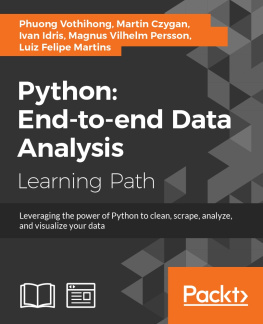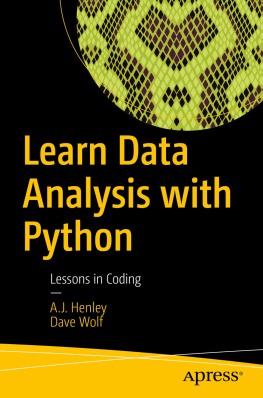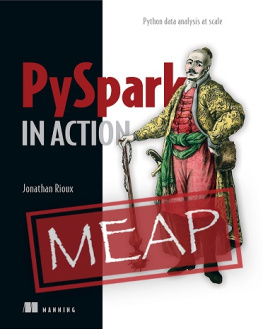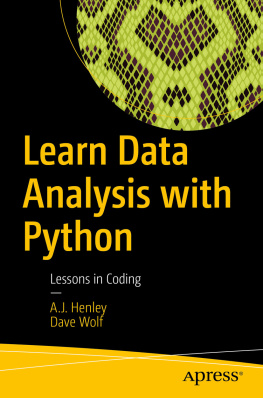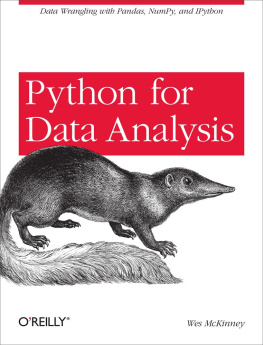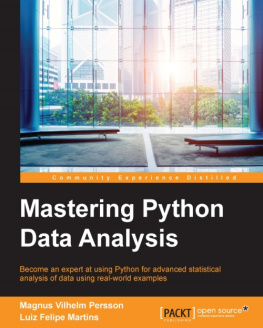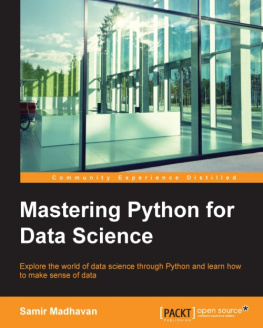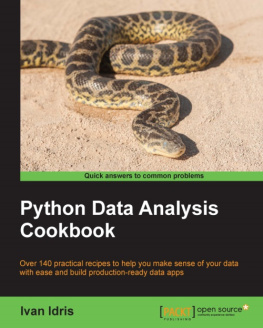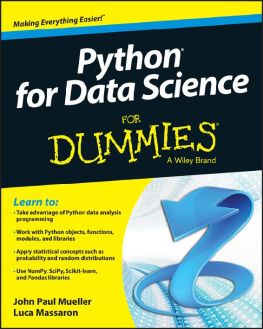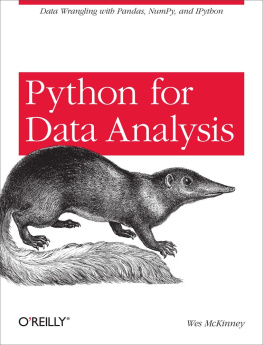Luiz Felipe Martins - Python: End-to-end Data Analysis
Here you can read online Luiz Felipe Martins - Python: End-to-end Data Analysis full text of the book (entire story) in english for free. Download pdf and epub, get meaning, cover and reviews about this ebook. year: 2018, publisher: Packt Publishing, genre: Home and family. Description of the work, (preface) as well as reviews are available. Best literature library LitArk.com created for fans of good reading and offers a wide selection of genres:
Romance novel
Science fiction
Adventure
Detective
Science
History
Home and family
Prose
Art
Politics
Computer
Non-fiction
Religion
Business
Children
Humor
Choose a favorite category and find really read worthwhile books. Enjoy immersion in the world of imagination, feel the emotions of the characters or learn something new for yourself, make an fascinating discovery.
- Book:Python: End-to-end Data Analysis
- Author:
- Publisher:Packt Publishing
- Genre:
- Year:2018
- Rating:5 / 5
- Favourites:Add to favourites
- Your mark:
- 100
- 1
- 2
- 3
- 4
- 5
Python: End-to-end Data Analysis: summary, description and annotation
We offer to read an annotation, description, summary or preface (depends on what the author of the book "Python: End-to-end Data Analysis" wrote himself). If you haven't found the necessary information about the book — write in the comments, we will try to find it.
Python: End-to-end Data Analysis — read online for free the complete book (whole text) full work
Below is the text of the book, divided by pages. System saving the place of the last page read, allows you to conveniently read the book "Python: End-to-end Data Analysis" online for free, without having to search again every time where you left off. Put a bookmark, and you can go to the page where you finished reading at any time.
Font size:
Interval:
Bookmark:
Leverage the power of Python to clean, scrape, analyze, and visualize your data
A course in three modules
BIRMINGHAM - MUMBAI
Copyright 2016 Packt Publishing
All rights reserved. No part of this course may be reproduced, stored in a retrieval system, or transmitted in any form or by any means, without the prior written permission of the publisher, except in the case of brief quotations embedded in critical articles or reviews.
Every effort has been made in the preparation of this course to ensure the accuracy of the information presented. However, the information contained in this course is sold without warranty, either express or implied. Neither the authors, nor Packt Publishing, and its dealers and distributors will be held liable for any damages caused or alleged to be caused directly or indirectly by this course.
Packt Publishing has endeavored to provide trademark information about all of the companies and products mentioned in this course by the appropriate use of capitals. However, Packt Publishing cannot guarantee the accuracy of this information.
Published on: May 2017
Production reference: 1050517
Published by Packt Publishing Ltd.
Livery Place
35 Livery Street
Birmingham B3 2PB, UK.
ISBN 978-1-78839-469-7
www.packtpub.com
Authors
Phuong Vo.T.H
Martin Czygan
Ivan Idris
Magnus VilhelmPersson
Luiz Felipe Martins
Reviewers
Dong Chao
Hai Minh Nguyen
Kenneth EmekaOdoh
Bill Chambers
Alexey Grigorev
Dr. VahidMirjalili
Michele Usuelli
Hang (Harvey) Yu
Laurie Lugrin
Chris Morgan
Michele Pratusevich
Content Development Editor
Aishwarya Pandere
Graphics
Jason Monteiro
Production Coordinator
Deepika Naik
The use of Python for data analysis and visualization has only increased in popularity in the last few years.
The aim of this book is to develop skills to effectively approach almost any data analysis problem, and extract all of the available information. This is done by introducing a range of varying techniques and methods such as uni- and multivariate linear regression, cluster finding, Bayesian analysis, machine learning, and time series analysis. Exploratory data analysis is a key aspect to get a sense of what can be done and to maximize the insights that are gained from the data. Additionally, emphasis is put on presentation-ready figures that are clear and easy to interpret.
, Getting Started with Python Data Analysis , shows how to work with time oriented data in Pandas. How do you clean, inspect, reshape, merge, or group data these are the concerns in this chapter. The library of choice in the course will be Pandas again.
, Python Data Analysis Cookbook , demonstrates how to visualize data and mentions frequently encountered pitfalls. Also, discusses statistical probability distributions and correlation between two variables.
, Mastering Python Data Analysis , introduces linear, multiple, and logistic regression with in-depth examples of using SciPy and stats models packages to test various hypotheses of relationships between variables.
Module 1:
There are not too many requirements to get started. You will need a Python programming environment installed on your system. Under Linux and Mac OS X, Python is usually installed by default. Installation on Windows is supported by an excellent installer provided and maintained by the community.This book uses a recent Python 2, but many examples will work with Python 3as well.
The versions of the libraries used in this book are the following: NumPy 1.9.2,Pandas 0.16.2, matplotlib 1.4.3, tables 3.2.2, pymongo 3.0.3, redis 2.10.3, and scikit-learn 0.16.1. As these packages are all hosted on PyPI, the Python package index, they can be easily installed with pip. To install NumPy, you would write:
$ pip install numpy
If you are not using them already, we suggest you take a look at virtual environments for managing isolating Python environment on your computer.For Python 2, there are two packages of interest there: virtualenv and virtualenvwrapper. Since Python 3.3, there is a tool in the standard library called pyvenv (https://docs.python.org/3/library/venv.html), which serves the same purpose.
Most libraries will have an attribute for the version, so if you already have a library installed, you can quickly check its version:
>>>importredis
>>>redis.__version__'2.10.3'
This works well for most libraries. A few, such as pymongo, use a different attribute(pymongo uses just version, without the underscores).While all the examples can be run interactively in a Python shell, we recommend using IPython. IPython started as a more versatile Python shell, but has since evolved into a powerful tool for exploration and sharing. We used IPython 4.0.0 withPython 2.7.10. IPython is a great way to work interactively with Python, be it in the terminal or in the browser.
Module 2:
First, you need a Python 3 distribution. I recommend the full Anaconda distribution as it comes with the majority of the software we need. I tested the code with Python 3.4 and the following packages:
joblib 0.8.4
IPython 3.2.1
NetworkX 1.9.1
NLTK 3.0.2
Numexpr 2.3.1
pandas 0.16.2
SciPy 0.16.0
seaborn 0.6.0
sqlalchemy 0.9.9
statsmodels 0.6.1
matplotlib 1.5.0
NumPy 1.10.1
scikit-learn 0.17
dautil0.0.1a29
For some recipes, you need to install extra software, but this is explained whenever the software is required.
Module 3:
All you need to follow through the examples in this book is a computer running any recent version of Python. While the examples use Python 3, they can easily be adapted to work with Python 2, with only minor changes. The packages used in the examples are NumPy, SciPy, matplotlib, Pandas, stats models, PyMC, Scikit-learn. Optionally, the packages basemap and cartopy are used to plot coordinate points on maps. The easiest way to obtain and maintain a Python environment that meets all the requirements of this book is to download a prepackaged Python distribution. In this book, we have checked all the code against Continuum Analytics' Anaconda Python distribution and Ubuntu XenialXerus (16.04) running Python 3.
To download the example data and code, an Internet connection is needed.
This learning path is for developers, analysts, and data scientists who want to learn data analysis from scratch. This course will provide you with a solid foundation from which to analyze data with varying complexity. A working knowledge of Python (and a strong interest in playing with your data) is recommended.
Feedback from our readers is always welcome. Let us know what you think about this coursewhat you liked or disliked. Reader feedback is important for us as it helps us develop titles that you will really get the most out of.
To send us general feedback, simply e-mail
Font size:
Interval:
Bookmark:
Similar books «Python: End-to-end Data Analysis»
Look at similar books to Python: End-to-end Data Analysis. We have selected literature similar in name and meaning in the hope of providing readers with more options to find new, interesting, not yet read works.
Discussion, reviews of the book Python: End-to-end Data Analysis and just readers' own opinions. Leave your comments, write what you think about the work, its meaning or the main characters. Specify what exactly you liked and what you didn't like, and why you think so.

